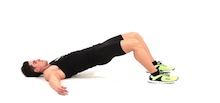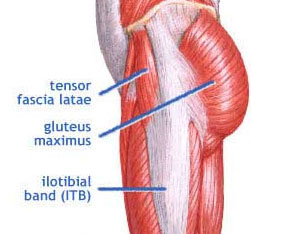
You may have seen a few of the trainers prescribe this exercise to members of the gym and wondered what all the fuss is about.
There are a few reasons that we would prescribe this exercise.
Due to modern living, most people’s movement patterns are poor as a result of our work and lifestyle choices. We spend most of our days crouched in a seated position behind a computer. All this sitting has lead to the usually strong gluteal muscles to become weak, which then leads to other muscles and joints compensating. For instance, if we have weak or shortened Glute muscles then we can lose stability in the sacrum and sacroiliac joint and this could lead to back pain.
In fact a study in 2011 [Barker 2011], suggested the Glute Max is the main stabiliser for the Sacroiliac Joint, so performing a Glute Bridge not only has an aesthetically pleasing outcome (a toned bum, who doesn’t want one), but also a functional and injury preventative outcome.
The Gluteal complex is also highly important in the human Gait cycle, as it gives us both stability and strength through our gait. A weakened Glute, will lead to other areas compensating for the lack of drive  through the hips and this results in a loss of stability through that process, (also performed by the Glutes), that will often affect the knees, due to it’s insertion into the IT (Iliotibial) band.
through the hips and this results in a loss of stability through that process, (also performed by the Glutes), that will often affect the knees, due to it’s insertion into the IT (Iliotibial) band.
Start by lying face up on the floor with arms to the side, knees bent, and heels on the ground. Lift your hips off the ground until knees, hips, and shoulders are in a straight line making sure to squeeze your Glutes as you reach the top of the movement.
All of your weight should be balanced between your shoulders and your feet. After holding for 1-2 seconds, slowly lower your hips back to the ground (3 seconds) and allow it to slightly touch the ground before completing another rep. This tempo is called a 1, 1, 3 meaning a one second concentric contraction, a one second hold at the top of the movement and a 3 second slow extension towards the floor. See the video below for a demonstration.
As you can see from the video a Mini Band is placed above the knee-joint whilst performing the exercise. The logic behind this is that the band forces the muscle to engage through it’s designated actions, being hip extension, external rotation of the hip and the force couple of adduction and abduction.
Try performing 3-4 sets of 10-15 reps. In between the sets go for a walk of about 10-20 metres between sets. This is demonstrated in the video below.
This walking between sets is very important, because it gives the body new proprioceptive feedback or positional awareness of the Glutes firing whilst walking. It is essentially re-wiring or training the correct muscle recruitment pattern while walking.
Performing correct neural activation whilst walking is critical to correct poor movement patterns. Poor movement patterns lead to poor posture, which then leads to pain.
If you are using this exercise to build strength through the Glutes, perform 2-3 times per week to start seeing results.
Barker PJ1, Hapuarachchi KS, Ross JA, Sambaiew E, Ranger TA, Briggs CA. Anatomy and biomechanics of gluteus maximus and the thoracolumbar fascia at the sacroiliac joint. 2011
Kendall, McCreary, Provance, Rodgers, Romani – Muscles: Testing and Function with Posture and Pain, 5th Edition, 2005
Biel, Andrew – Trail Guide to Movement: Building the body in motion, 2015
No Comments to "Rehab Exercise of the Month – The Glute Bridge"